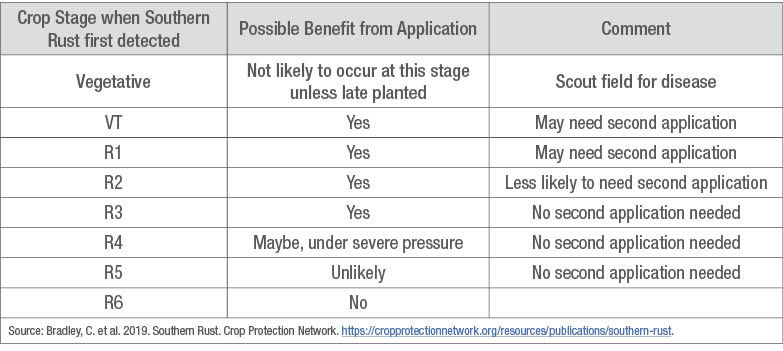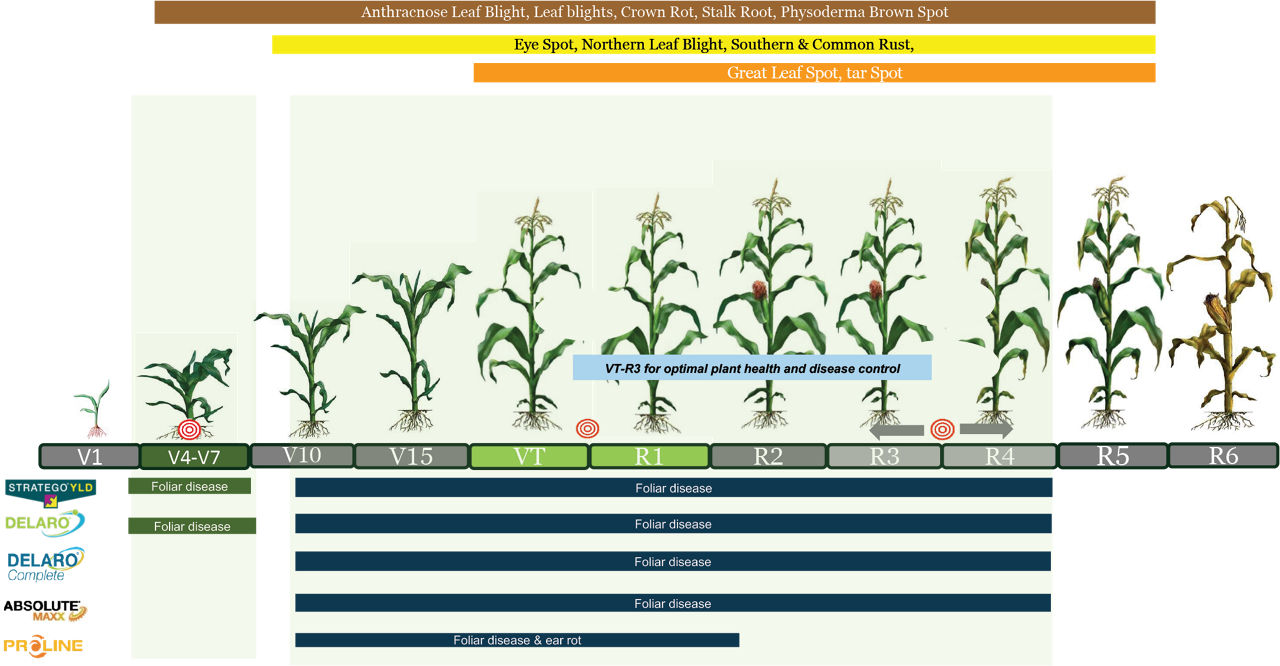5 MIN READ
Identifying and Managing Southern Rust of Corn
August 21, 2024
Introduction
There are two types of rusts that can affect corn in the United States and southern Canada. Southern rust is much more destructive than common rust. At severe levels southern rust can reduce photosynthesis and lead to premature dry-down of corn plants, a reduction of kernel weight, and a lowered yield potential.
KEY POINTS
- Southern rust is a tropical foliar disease that can reduce the photosynthetic area on the plant and cause premature plant drying.
- Southern rust pustules (lesions) can occur on leaves, stalks, and husks.
- Pustules are mostly found on the upper leaf surface.
- Pustules are densely clustered and circular in shape with a light orange color.
- Southern rust is often confused with common rust.
- Corn products can vary in their susceptibility to southern rust disease.
Identifying and Managing Southern Rust of Corn
Corn southern rust is caused by the fungus Puccinia polysora and can occur in major corn production regions in the United States and in extreme southern Canada.1 A similar disease, common rust—which very rarely causes production problems—is sometimes mistaken for southern rust. Southern rust pustules are raised masses of colored spores that rupture the epidermal leaf tissue. They appear as densely packed, small, brownish-orange ovals and occur almost exclusively on the upper leaf surface. As southern rust pustules age, they become dark brown to black, often forming dark halos around the original pustule. Common rust pustules can be distinguished from southern rust pustules because common rust pustules are more loosely scattered on the leaf surface, are reddish brown (brick colored), and are elongated in shape. Pustules caused by either disease are usually found on the upper canopy. Infections of both rusts can occur on the same plant, which can make diagnosis difficult (Figure 1).


Disease Cycle
The P. polysora fungus requires a live host to survive, so in Canada and most of the United States it does not overwinter and must recolonize every year. North-blowing winds carry the fungal spores from tropical areas to corn fields in temperate areas, where the spores can infect any corn plant they land on if environmental conditions are favorable. Leaf wetness and air temperature are both critical for infection to occur. Six hours of dew usually provides enough moisture for rust infection. Common rust prefers somewhat lower temperatures of 61 to 77 °F, and southern rust prefers higher temperatures of 77 to 88 °F.1 The difference in ideal temperatures means common rust usually shows up first and southern rust is typically a late-summer occurrence.
Each pustule produces thousands of spores that can infect the plant and produce additional pustules in as few as seven days. If conditions are favorable the infection cycle will continually repeat resulting in secondary infections, so southern rust disease intensity can reach epidemic levels very quickly. Young leaves are more susceptible to infection, so late-planted corn may be at greater risk for infection. Generally, favorable conditions for southern rust are more prevalent in the southern United States than in other North American corn-growing regions, and the disease is more of an economic issue in these states.
Economic impact
Southern rust can rob the plant of nutrients required for grain fill by reducing the photosynthetic area on the corn plant, thus reducing yield potential. Pustules can rupture the epidermis, impacting water regulation in the leaf. Severe infections can increase susceptibility to stalk rot pathogens. Yield losses as high as 45 percent have been reported when the disease is severe.2
Predicting the Occurrence
A network of Land Grant University Extension systems developed a map to monitor the movement of southern corn rust during the growing season. It can be accessed at the website: https://corn.ipmpipe.org/southerncornrust/.
Management
Cultural practices are of limited use against southern rust, since the spores are wind-blown from far away and carried into the area. However, resistant corn products should be selected when planting corn late, because late-planted corn may be at a higher risk of infection.
Most corn products are susceptible to southern rust, but there are some resistant products. One version of southern rust resistance in corn is conferred by the Rpp9 gene, though in 2008 researchers in Georgia discovered a new strain of the southern rust fungus that was not affected by the Rpp9 resistance gene.3 Another version of southern rust resistance uses multiple genes to create resistance in the corn plant, and this version confers some resistance against all known strains of southern rust. While southern rust pustules can still be observed on corn with this new genetic resistance, infections are less severe and fungicide control is made more effective.
Foliar fungicides are effective at protecting uninfected leaf tissue from southern rust, but currently there is no established treatment threshold for this disease. Before using a fungicide, consider the following factors:
- The threat or occurrence of southern rust in the area
- Development stage of the crop
- Yield potential
- Type of irrigation, if applicable
- Environmental conditions that favor disease development
Delaro® Complete Fungicide is labeled for control of southern rust and is recommended at the appearance of the disease. If favorable conditions for disease development continue, further Delaro® Complete Fungicide applications can be made on a 14-day schedule (Figure 3).2 Fungicides provide the greatest benefit to yield potential when applied between the silking (R1) and milk (R3) stages when southern rust has been detected. Always read and follow pesticide label directions.


Sources
1 Ahumada, D. 2023. Corn rusts: Common and southern rust. North Carolina State Extension. NC State Extension Publications. https://content.ces.ncsu.edu/corn-rusts-common-and-southern-rust
2 Bradley, C., Allen, T., Faske, T., et al. 2019. An overview of southern rust. Crop Protection Network, CPN 2019. https://cropprotectionnetwork.org/publications/an-overview-of-southern-rust
3 Chen, G., Zhang, B., Ding, J., et al. 2022. Cloning southern corn rust resistant gene RppK and its cognate gene AvrRppK from Puccinia polysora. Nature Communications. 13: 4392. https://www.nature.com/articles/s41467-022-32026-4
Web sites verified 03/18/2024 1211_59621
You may also like...
Here are some articles that may also be of interest to you